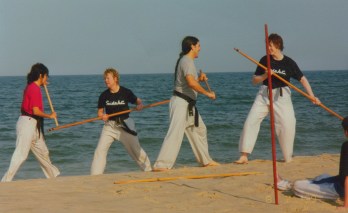
Last Tuesday (the class before Thanksgiving) we had a bit of a milestone in my youth class. If we don't count myself or the brown belts who were helping with class, we had more girls than boys in the class. I think that's the first time that's happened since we started that class. We usually have more men and boys than women and girls.
Martial arts overall tends for be male-dominated -- if we go back a few decades, women weren't even allowed to train in many schools and styles. Though there are also a few arts, like naginata-justsu and Wing Chun, that have always accepted women or even been regarded mostly as arts for them. And sometime clever teachers found ways around the rules; they might not officially let women train but would let them watch and practice forms and give corrections after class.
Sexism is stupid but it's a fact of history, and it had an impact on the martial arts.
But I'm very proud that in Seido karate we have pretty close to gender parity. We've had such great women as the late Sei Shihan Michelle Cuttino -- not only an accomplished karateka but a jukoka as well, she once visited us in Maryland and gave an impromptu demonstration where she pinned me quite effectively, despite my weight advantage of forty pounds or so; and Sei Shihan Nancy Lanoue, who with her partner and wife Jun Shihan Sarah Ludden has done amazing work in connecting martial arts with social justice and violence prevention. (Bonus content: a 1988 Chicago Tribune article about Sei Shihan Nancy.)
My students know that my sensei is Jun Shihan Kate Stewart, one of the leading women in Seido. She's been my teacher for over twenty years, though she wasn't my first sensei in Seido. I trained under two men, Sensei Neal Pendleton and Sensei Marion Ciekot, before that -- Jun Shihan Kate was shodan and my senpai back when I started training. But actually my first martial arts teacher was Sensei Mary Ann Ahrens, my ju-jitsu teacher when I was a kid. So I owe both my current training and my very first experiences in the martial arts to women.
There can be a bit of an extra challenge for women and girls when they first start training. At the beginning most of us tend to try to "muscle" our way through techniques, relying on the muscles of the arms and chest to power a strike. It's true that on average, women have less upper body strength than men, and so at this early stage they might come to feel that they just can't hit hard. But as someone who has been punched and kicked by quite a few women in the dojo over the years, I can attest that that is not the case!
As we develop our technique we learn to power our techniques through the legs, hips, and pelvis, using the "core" muscles to put the whole body into a strike. And there is less of a difference in raw muscle strength here -- women may even have greater core strength. Also as we develop technique, flexibility comes more into play, the ability to relax one muscle while tightening its antagonist. And women may, on average, have an advantage in flexibility and coordination. They also seem to have sharper senses of vision and hearing, which can give an advantage in sparring.
We have to use a lot of "maybes" and "probablys" here, because for most of history boys and girls were socialized very differently, and still are to some degree. So even if they started with the same capabilities as babies they would develop them differently. It's not easy to say what differences in athletic performance are entirely due to biology, and what might be due to the different ways girls and boys are encouraged to play and thus to develop their bodies early on.
And of course on any given capability, there will be overlap. For example men may have greater upper body strength on average, but there are women weightlifters out there who can bench press more than I can.
So all students, men and women, boys and girls, bring different sets of strengths and weaknesses to their training. Good martial arts training should allow and encourage each student to use their strengths while also helping them to develop weak areas. The diversity of body types and life experiences that students bring to the dojo ends up being something that benefits us all.